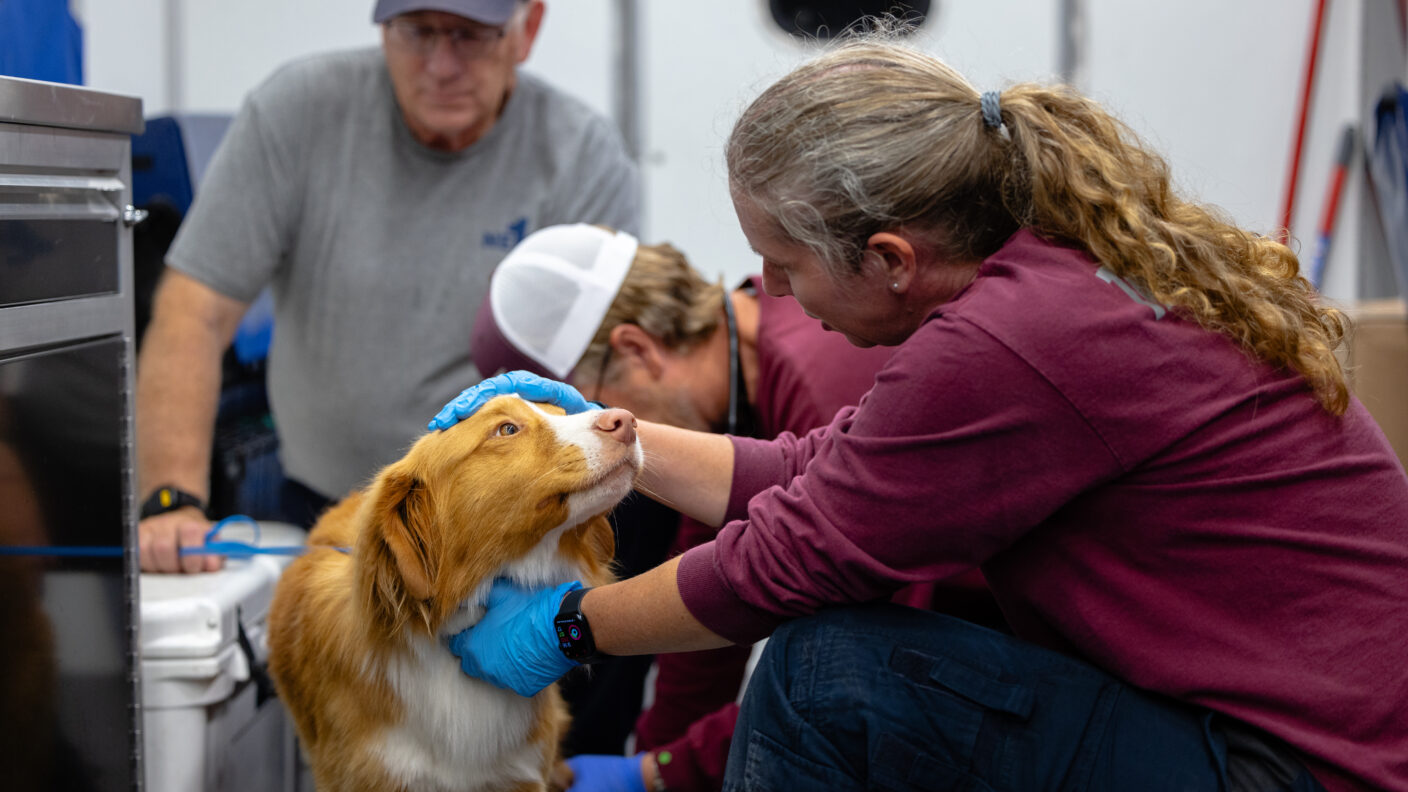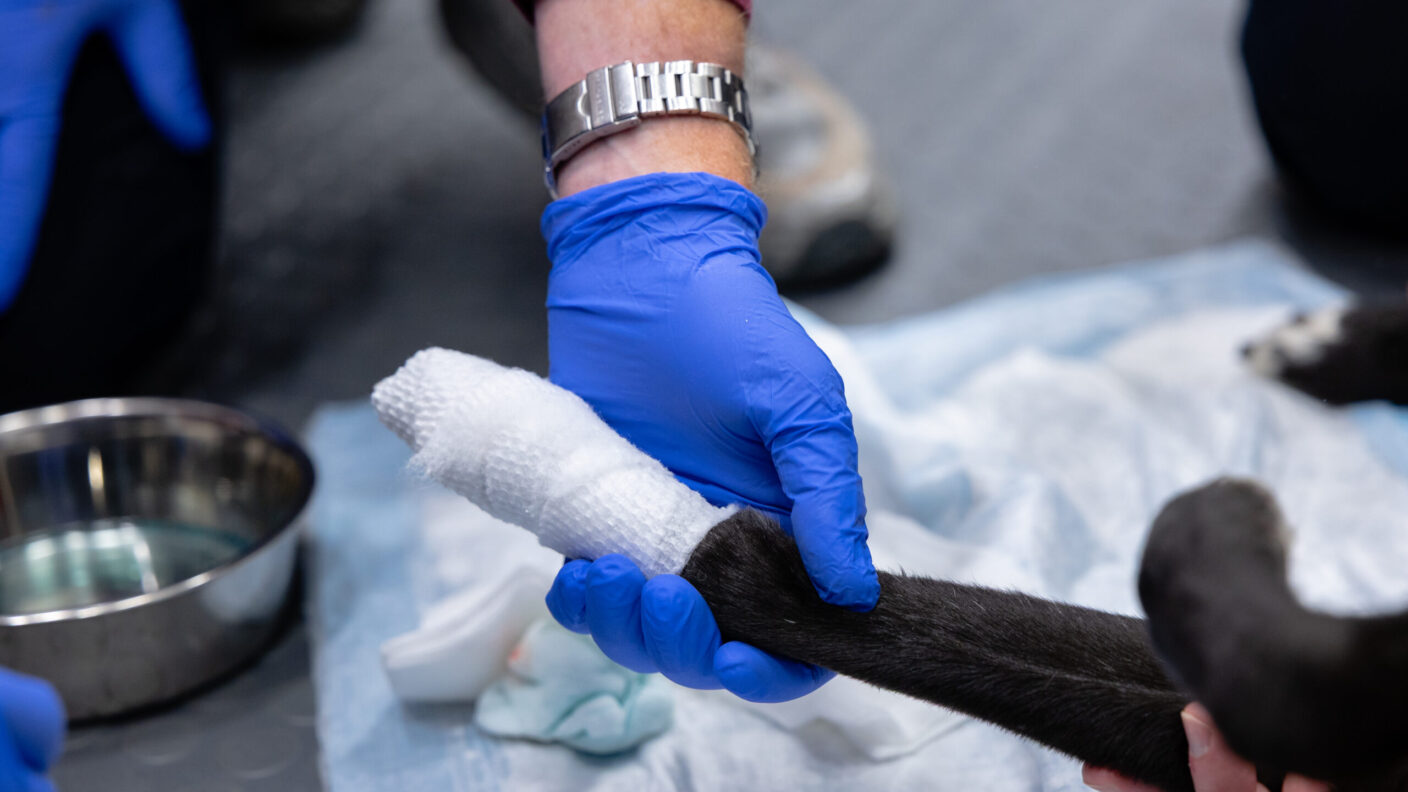Caring For Canine Heroes
Texas A&M serves search and rescue dogs deployed to Central Texas.

The Texas A&M Veterinary Emergency Team (VET) is working with Texas A&M Task Force 1 and other states’ Task Force 1 search and rescue dogs stationed in Comfort, Texas, following floods that hit central Texas on July 4.
They have been, perhaps, among the unsung heroes of search and rescue.
The canine members of the Texas A&M Task Force (TX-TF) urban search and rescue (SAR) teams can do many things their human counterparts can’t: their athletic frames and fearlessness allow them to squeeze into tight spaces; their agility allows them to maneuver unstable surfaces; and their exquisitely sensitive, trained noses allow them to sniff out the missing (through microscopic molecules in your breath!) to a precision unthinkable for humans.
The impact these dogs make cannot be denied. But the work is incredibly dangerous — the nature of the job requires them to work in all environments and around many hazards.
“The most successful SAR dogs are very highly driven; they do not make good pets. They make good search dogs because they are so intense and driven,” said Dr. Deb Zoran, a professor and director of the Texas A&M College of Veterinary Medicine & Biomedical Sciences’ (VMBS) Veterinary Emergency Team.
“When they and their handlers get deployed into a disaster, the mission is to find, save or recover missing people, and they often have to go to work on a moment’s notice,” she said.
[Search and rescue dogs] do not make good pets. They make good search dogs because they are so intense and driven.
Zoran pulls double duty as a member of the Texas A&M Veterinary Emergency Team (VET) and the team veterinarian for TX-TF 1 and 2. For the past 15 years, her primary objective when training or deploying with either team is to keep these dogs healthy, at peak performance, and mission ready.
To her, the relationship between the SAR dogs, their handlers, and the veterinarian is of the utmost importance. While they’re working during a disaster — from wildfires to flooding responses and everything in between — SAR dogs depend on both their handler’s ability to recognize the tiniest differences in behavior or movement that may indicate injury and Zoran to support them before, during, and after a mission.
“When they are deployed in our Texas climate, they are at particular risk of hyperthermia, dehydration, and many injuries — muscle strains or trauma to their legs or foot pads — as well as for interactions with snakes, scorpions, fire ants, and other hazards that can happen in the process,” Zoran said.
“Despite these hazards, there are several recurring risks for the dogs as they work more or less year-round in the southern U.S., and those are overheating and dehydration as well as issues related to their feet and lower legs,” Zoran said. “All of these things impact the dogs’ ability to complete the search, which then affects the team’s ability to find that missing human; they also have a profound impact on the canine nose’s scenting function. Dehydration, in particular, reduces the ability for noses to uptake odor, while overheating makes the nose’s internal membranes dry out, also reducing the ability to detect odor.”

Zoran says the relationship between the SAR dogs, their handlers, and the veterinarian is of the utmost importance.
The work can be grueling, but these dogs’ value cannot be overestimated, especially during times of disaster, such as the recent Central Texas flooding, according to Zoran.
“A certified SAR dog is one of the most valuable members on a search and rescue team for finding a missing person,” Zoran said. “These dogs are pretty amazing animals, and it is a true joy for me to work with both the handlers and dogs and to be a part of keeping these incredible teams on mission.”
Search and rescue handlers also value the relationship between TX-TF and VET in keeping their beloved canines safe and healthy.
“Canyon and Connor are more than just working partners to me; they’re family members and my best friends,” said Christy Bormann, one of the seven Texas A&M Task Force search and rescue handlers currently deployed in the Texas Hill Country. “Their health and safety are critical to me. I know that we all put ourselves at risk to do this critical job.
“Knowing that the VET is available allows me to know they have the very best care available during their search missions,” Bormann said. “The VET has consistently gone above and beyond to ensure that Canyon and Connor are healthy and able to serve our community. Dr. Zoran is always available to answer our questions and work with us — even on our training days. We are so privileged to have her as part of our team.”
